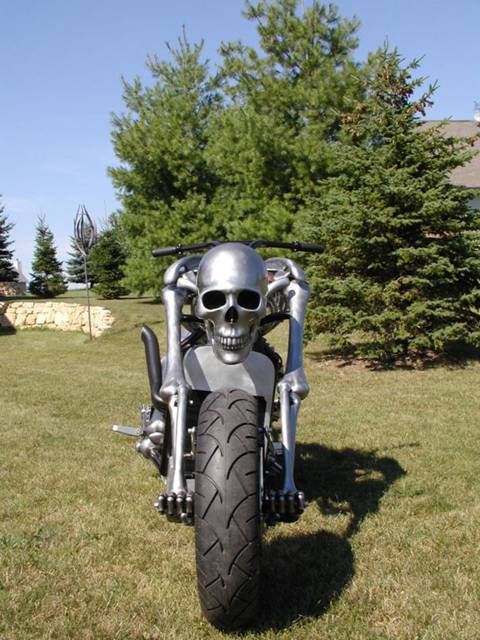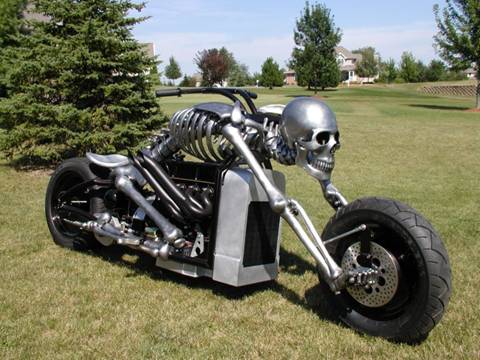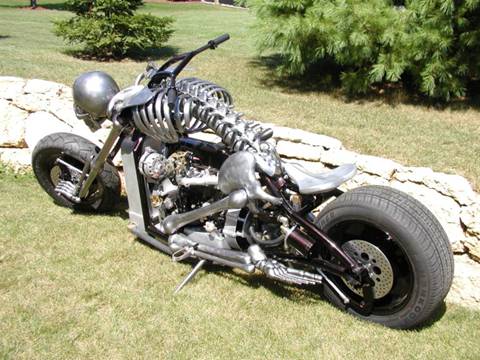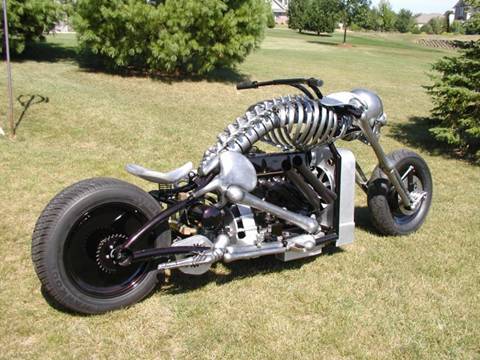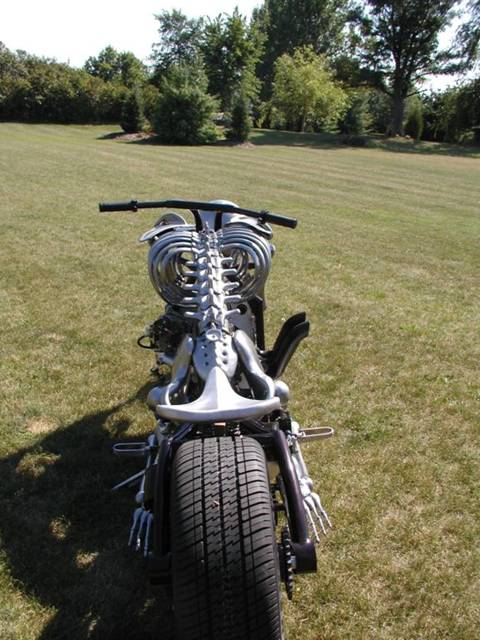Ecosse Heretic Titanium Series - It is the world's costiest motorcycle...

First thought, cost?......it is $275,000 (around INR 11000000), and only 10 units are available worldwide.
So why is it so costly?....Of course everything about it should be special, right? So here are the details :
It features the world’s first all-titanium frame, hence the Titanium Series moniker. Powering it is a 200 horsepower 2,150cc polished billet aluminium supercharged and intercooled V-Twin engine that makes 285Nm of torque, rather insane for a naked bike that weighs about 200kg.


The front suspension system use fully adjustable Ohlins FG700 Superbike Gas with a titanium front axle, while the rear suspension is a fully adjustable Ohlins Racing Shock setup. The bodywork is clear-coated carbon fiber, which includes the fuel tank.
Free Offer :-
Ecosse has offered to sweeten the deal by throwing in a free (and very spiffy) watch with every Ecosse Titanium Series sold - so, frankly, it’s a bit of a bargain if you don’t have a watch. And if that doesn’t convince you, here’s another angle on those mouth-watering triple clamps:

You can purchase the Ecosse Titanium Series from the good burghers at RobbReport.com, to whom we owe picture credits and probably an apology for maybe not taking this bike as seriously as we could. But then we’re not the target market. Incidentally, if anyone out there happens to know somebody who buys one of these, please put them in touch with us - we’d dearly love to hear about the Ecosse ownership experience.
 Full specifications for this epic machine can be found here, and the down-at-heel can take a look at some of Ecosse’s “budget” models at the Ecosse Moto website.
Full specifications for this epic machine can be found here, and the down-at-heel can take a look at some of Ecosse’s “budget” models at the Ecosse Moto website.Continue Reading...
Motorcycle Controls
Nearly all motorcycles have standard transmissions, so you must shift them yourself. As on bicycles, motorcycles typically have two brake controls, one for the front tire, and a separate one for the rear tire. Also, motorcycles have on/off switches, starter buttons, a throttle, turn signals, and horns. To control a motorcycle you use both of your hands and both of your feet.
Ignition Switch
Usually located near the instrument cluster, its positions usually include ON, OFF, LOCK, and PARK. The Lock position allows the key to be removed and engages a steering-lock mechanism. When locked, your motorcycle can only move in circles, unless a couple of Samoans pick it up and toss it into the back of their Ford F250. The Park position is a Lock position that also leaves the taillight on. Park is good for draining your battery in about an hour, leaving you no easy way to start your computerized-ignition electronic-fuel-injected electric-start bike. I believe the Park position is actually a clever built-in IQ test.
Clutch lever
 This lever operates the clutch. Squeezing the clutch lever towards you with the fingers of your left hand will disengage the clutch and disconnect the engine power from the rear wheel. Releasing the lever will engage the clutch and provide power to the rear wheel.
This lever operates the clutch. Squeezing the clutch lever towards you with the fingers of your left hand will disengage the clutch and disconnect the engine power from the rear wheel. Releasing the lever will engage the clutch and provide power to the rear wheel.
You will use the clutch when you
* select and change gears
* put the motorcycle into neutral
* carry out some slow-speed maneuvers
To change or select a gear
1. Pull the clutch lever fully to the handlebar
2. Select the gear you need with your left foot
3. Release the clutch lever smoothly to engage the clutch
High beam / Low beam switch
This is used to switch your headlamp between high beam and low beam. You operate it with your left thumb. On high beam you'll probably see a blue light on your instrument panel.
Horn
On most motorcycles, this makes a plaintive bleating sound which can be used to attract sheepdogs and send drunken friends into episodes of spasmodic laughter. On the freeway it's just slightly less effective than spitting.
Turn Signal Switch / Indicator
On most motorcycles you push the button to the left to indicate a left turn, to the right to indicate a right turn, and you push the button straight in to turn off the turn signals. Use your thumb to operate the switch.
Harleys and BMWs have the left turn signal on the left handlebar and the right turn signal on the right handlebar. You push a second time to cancel.
Engine cut-off switch
This allows you to shut off the engine without removing your hand from the handlebar. You operate it with your thumb. When stopping the engine normally, use the ignition switch. You're less likely to leave your keys in the ignition when leaving your motorcycle.
Electric starter
Most motorcycles won't start unless the clutch is pulled in. To start your motorcycle:
1. Check that the engine cut-out switch is on
2. Switch the ignition on
3. Pull in the clutch lever
4. Make sure that the gear selector is in neutral
5. Press the starter button
When the engine starts, immediately release the starter button. You can damage the starter clutch (an expensive little thingy deep inside the engine) by running the starter while the engine is also running.
Front brake lever
This applies the brake to the front wheel. To use it squeeze the lever towards you. Use all the fingers on your right hand for maximum control and stopping power. The harder you squeeze, the harder you brake. To release the brake release the lever.
Throttle
The throttle controls the engine power, exactly like the accelerator pedal in a car.
To speed up the engine twist the throttle towards you. To slow down the engine release the throttle or twist the grip away from you. Most throttles will spring back to a closed position when released. In this position the engine will run at 'idle' speed.
Shift lever foot control
Gears enable you to match engine power to road speed. You use a low gear to start off and a higher gear once you've gained speed. Changing smoothly through the gears is a skill that will improve with practice. The gear selector is usually on the left side of the motorcycle, just in front of the footrest.
The neutral position is when no gear is engaged. Most motorcycles have a green warning light to show when the gears are in neutral.
Gears are selected by lifting or pushing down the gear lever with your foot. Push down for a lower gear. Pull up for a higher gear. When you release the lever, it will return to the center position, ready to select another gear. Most motorcycles have five or six gears. A typical gear pattern is 1-N-2-3-4-5. The N is for neutral, which is selected by either a half lift from 1st gear or a half push from 2nd gear.
Rear brake pedal foot control
This pedal is usually on the right side of the motorcycle, just in front of the footrest. Push = stop.
Instruments
1. Speedometer - tells you your speed.
2. Odometer -total miles since the motorcycle was new.
3. Trip odometer - miles since last reset.
4. Engine trouble light - should be off when engine is running.
5. Neutral lamp - lights up when transmission is in neutral.
6. Tachometer - engine speed in RPM. Don't get into "red."
7. Turn signal indicators - blink when turn signals are on.
8. High beam indicator - blue when high beam is on.
9. Oil pressure lamp - if engine is running, on = bad.
Steering a Motorcycle
Motorcycles work much like bicycles; however they weigh a lot more, so to get maximum performance you have to push and pull harder. This makes it more apparent how they actually work.
On any two wheel vehicle there is a transition speed, which is typically about 2 mph. Most people can't ride a motorcycle or a bicycle below 2mph, so they're unaware of this. Below the transition speed, you steer a motorcycle like a car: you point the front wheel where you want to go. Above the transition speed, you do exactly the opposite: you push on the handlebars to make the front wheel move in the opposite direction, and the motorcycle leans into the curve and starts to turn. This is called counter-steering. This fact is why you fell down on the bicycle the first few times: your brain had to learn to do opposites. Beginners often don't believe these statements, so here's an easy test. Get going about 35-40 mph on a motorcycle on a long straight road without traffic. Remove your left hand from the handlebars. Now using your right hand only, push the right handlebar forward gently. The bike will start to turn to the right. Pull the right handlebar gently towards you and the bike will pick back up to straight, and, if you keep pulling, start to turn to the left.
A very important rule on motorcycles is that you go where you look. If you want to turn, first look towards where you want to go. Next, press on the handlebars. If you want to turn left, press on the left handlebar and the motorcycle will start to lean to the left and turn to the left.
Finally, lean with the bike. Many beginners are very uncomfortable leaning, and want to sit up on top of the motorcycle. This just makes the motorcycle lean further to accomplish the same turn. In normal street riding, you can just lean with the bike at the same angle as the bike and you'll be fine. Some beginners wish they could turn without leaning. Sorry, can't be done: laws of physics. In racing situations, riders get underneath the bike for better control.
Above, we see a racer who is looking where he wants to go, pulling on the left handlebar to continue to turn right, and leaning into the corner - in this case to the point where his knee is on the pavement. You won't be cornering quite this fast in the next few months.
When you're cornering, it's best to hold the throttle on slightly so as to maintain speed, or even very slightly increase speed through the corner. Most bikes work best when they are slightly accelerating. If you suddenly get off the gas, the weight will transfer to the front tire and the bike will turn into the corner very sharply. This is very disconcerting for a beginner. It's best to maintain speed through the corner. This means you have to learn to judge cornering speeds and do your braking before you enter the corner.
That's about all I have to say on steering, because this is a skill you learn from practice, not from reading.
Nearly all motorcycles have standard transmissions, so you must shift them yourself. As on bicycles, motorcycles typically have two brake controls, one for the front tire, and a separate one for the rear tire. Also, motorcycles have on/off switches, starter buttons, a throttle, turn signals, and horns. To control a motorcycle you use both of your hands and both of your feet.
Ignition Switch
Usually located near the instrument cluster, its positions usually include ON, OFF, LOCK, and PARK. The Lock position allows the key to be removed and engages a steering-lock mechanism. When locked, your motorcycle can only move in circles, unless a couple of Samoans pick it up and toss it into the back of their Ford F250. The Park position is a Lock position that also leaves the taillight on. Park is good for draining your battery in about an hour, leaving you no easy way to start your computerized-ignition electronic-fuel-injected electric-start bike. I believe the Park position is actually a clever built-in IQ test.
Clutch lever
 This lever operates the clutch. Squeezing the clutch lever towards you with the fingers of your left hand will disengage the clutch and disconnect the engine power from the rear wheel. Releasing the lever will engage the clutch and provide power to the rear wheel.
This lever operates the clutch. Squeezing the clutch lever towards you with the fingers of your left hand will disengage the clutch and disconnect the engine power from the rear wheel. Releasing the lever will engage the clutch and provide power to the rear wheel.You will use the clutch when you
* select and change gears
* put the motorcycle into neutral
* carry out some slow-speed maneuvers
To change or select a gear
1. Pull the clutch lever fully to the handlebar
2. Select the gear you need with your left foot
3. Release the clutch lever smoothly to engage the clutch
High beam / Low beam switch
This is used to switch your headlamp between high beam and low beam. You operate it with your left thumb. On high beam you'll probably see a blue light on your instrument panel.
Horn
On most motorcycles, this makes a plaintive bleating sound which can be used to attract sheepdogs and send drunken friends into episodes of spasmodic laughter. On the freeway it's just slightly less effective than spitting.
Turn Signal Switch / Indicator
On most motorcycles you push the button to the left to indicate a left turn, to the right to indicate a right turn, and you push the button straight in to turn off the turn signals. Use your thumb to operate the switch.
Harleys and BMWs have the left turn signal on the left handlebar and the right turn signal on the right handlebar. You push a second time to cancel.
Engine cut-off switch
This allows you to shut off the engine without removing your hand from the handlebar. You operate it with your thumb. When stopping the engine normally, use the ignition switch. You're less likely to leave your keys in the ignition when leaving your motorcycle.
Electric starter
Most motorcycles won't start unless the clutch is pulled in. To start your motorcycle:
1. Check that the engine cut-out switch is on
2. Switch the ignition on
3. Pull in the clutch lever
4. Make sure that the gear selector is in neutral
5. Press the starter button
When the engine starts, immediately release the starter button. You can damage the starter clutch (an expensive little thingy deep inside the engine) by running the starter while the engine is also running.
Front brake lever
This applies the brake to the front wheel. To use it squeeze the lever towards you. Use all the fingers on your right hand for maximum control and stopping power. The harder you squeeze, the harder you brake. To release the brake release the lever.
Throttle
The throttle controls the engine power, exactly like the accelerator pedal in a car.
To speed up the engine twist the throttle towards you. To slow down the engine release the throttle or twist the grip away from you. Most throttles will spring back to a closed position when released. In this position the engine will run at 'idle' speed.
Shift lever foot control
Gears enable you to match engine power to road speed. You use a low gear to start off and a higher gear once you've gained speed. Changing smoothly through the gears is a skill that will improve with practice. The gear selector is usually on the left side of the motorcycle, just in front of the footrest.
The neutral position is when no gear is engaged. Most motorcycles have a green warning light to show when the gears are in neutral.
Gears are selected by lifting or pushing down the gear lever with your foot. Push down for a lower gear. Pull up for a higher gear. When you release the lever, it will return to the center position, ready to select another gear. Most motorcycles have five or six gears. A typical gear pattern is 1-N-2-3-4-5. The N is for neutral, which is selected by either a half lift from 1st gear or a half push from 2nd gear.
Rear brake pedal foot control
This pedal is usually on the right side of the motorcycle, just in front of the footrest. Push = stop.
Instruments
1. Speedometer - tells you your speed.
2. Odometer -total miles since the motorcycle was new.
3. Trip odometer - miles since last reset.
4. Engine trouble light - should be off when engine is running.
5. Neutral lamp - lights up when transmission is in neutral.
6. Tachometer - engine speed in RPM. Don't get into "red."
7. Turn signal indicators - blink when turn signals are on.
8. High beam indicator - blue when high beam is on.
9. Oil pressure lamp - if engine is running, on = bad.
Steering a Motorcycle
Motorcycles work much like bicycles; however they weigh a lot more, so to get maximum performance you have to push and pull harder. This makes it more apparent how they actually work.
On any two wheel vehicle there is a transition speed, which is typically about 2 mph. Most people can't ride a motorcycle or a bicycle below 2mph, so they're unaware of this. Below the transition speed, you steer a motorcycle like a car: you point the front wheel where you want to go. Above the transition speed, you do exactly the opposite: you push on the handlebars to make the front wheel move in the opposite direction, and the motorcycle leans into the curve and starts to turn. This is called counter-steering. This fact is why you fell down on the bicycle the first few times: your brain had to learn to do opposites. Beginners often don't believe these statements, so here's an easy test. Get going about 35-40 mph on a motorcycle on a long straight road without traffic. Remove your left hand from the handlebars. Now using your right hand only, push the right handlebar forward gently. The bike will start to turn to the right. Pull the right handlebar gently towards you and the bike will pick back up to straight, and, if you keep pulling, start to turn to the left.
A very important rule on motorcycles is that you go where you look. If you want to turn, first look towards where you want to go. Next, press on the handlebars. If you want to turn left, press on the left handlebar and the motorcycle will start to lean to the left and turn to the left.
Finally, lean with the bike. Many beginners are very uncomfortable leaning, and want to sit up on top of the motorcycle. This just makes the motorcycle lean further to accomplish the same turn. In normal street riding, you can just lean with the bike at the same angle as the bike and you'll be fine. Some beginners wish they could turn without leaning. Sorry, can't be done: laws of physics. In racing situations, riders get underneath the bike for better control.
Above, we see a racer who is looking where he wants to go, pulling on the left handlebar to continue to turn right, and leaning into the corner - in this case to the point where his knee is on the pavement. You won't be cornering quite this fast in the next few months.
When you're cornering, it's best to hold the throttle on slightly so as to maintain speed, or even very slightly increase speed through the corner. Most bikes work best when they are slightly accelerating. If you suddenly get off the gas, the weight will transfer to the front tire and the bike will turn into the corner very sharply. This is very disconcerting for a beginner. It's best to maintain speed through the corner. This means you have to learn to judge cornering speeds and do your braking before you enter the corner.
That's about all I have to say on steering, because this is a skill you learn from practice, not from reading.
[Source]
Continue Reading...
BAL to BHIL
Pursuant to the Scheme, Bajaj Auto Ltd is re-named as Bajaj Holdings & Investment Ltd. New F&O contracts is to be introduced today; futures lot size of 250 shares, options strike priced between Rs 20-2700.
It goes ex-demerger (goes into ND period; out on Mar 24). Auto stock will re-list later ((Technically Bajaj Auto is delisting and Holdings arm is listing).
Bajaj Auto has fixed March 25, 2008 as record date for determining the shareholders of the Company, who would be eligible to receive shares of Bajaj Auto Ltd (new) and Bajaj Finserv Ltd in the ratio of 1:1.
The Hon'ble High Court of Judicature at Bombay has sanctioned the Scheme Arrangement between Bajaj Auto Ltd, Bajaj Holdings & Investment Ltd and Bajaj Finserv Ltd and its respective shareholders and creditors. This marks the successful completion of the demerger process, which was initiated by the Company with the Board approval on May 17, 2007. The demerger reinforces the commitment of Bajaj Auto Ltd group to the businesses of the resulting Companies.
==> Highlights of the Scheme of De-merger :-
(a) Bajaj Auto Ltd (the new name of Bajaj Holdings & Investment Ltd under the scheme) to focus on auto business.
(b) Bajaj Finserv Ltd (BFS) to focus on wind energy generation, insurance, consumer finance, financial products distribution business and new initiatives in financial services space and
(c) Bajaj Holdings & Investment Ltd (the new name of Bajaj Auto Ltd under the scheme) will function primarily as an investment Company and focus on new business opportunities.
Continue Reading...
TVS Flame - Single Spark Technology
After losing the long technical-legal battle with Bajaj over its new bike Flame, TVS is again brining the same bike into production but with a different engine this time.
The earlier CC-VTi engine had two spark plugs and three valves (first-outlet, second-inlet). At low RPM’s only two valves were functional and the third valve (inlet) became functional at high RPM’s. It was this because of the use of two spark plug for its single cylinder configuration, TVS was asked by the Madras High Court to stop selling and producing the 125 cc Flame. According to Bajaj Auto this was an infringement of their patented DTSi (Digital Twin Spark Plug Ignition) technology.
This time the company incorporated a single-spark ignition engine based on controlled combustion variable timing intelligent (CC-VTi) technology.
The engine has been developed and patented by Austria-based AVL and has been licensed to TVS in India. AVL is the world leader in internal combustion engine technology and develops power train systems. It is a leading provider of technology to the global engine and automotive industry.
Its mileage/fuel efficiency is still not clear with different opinions from different people :-
(1). “There would be no difference in terms of efficiency,” Venu Srinivasan, chairman and managing director of TVS, said. --- according to livemint.com(2). Apart from the conversion of twin spark plug technology to single spark plug ignition, everything else would be the same in Flame, Srinivasan said. The new version of Flame will give a standard mileage of 60-65 km per litre. --- according to sify.com
The showroom price for the new Flame has been kept at Rs 46,000.
Now the question is : "Will this spark turn to Flame ? "
The company, on Sunday, also entered the three-wheeler market, dominated by Bajaj, by announcing the launch of a 200cc auto-rickshaw named ‘TVS King’ :-
Venu Srinivasan in the new 3-wheeler "TVS King"
Continue Reading...
Planning to buy a new bike ? Buy it Now...
The FM, P Chidambaram sprang a welcome surprise, slashing excise duty on small cars and two wheelers from 16% to 12%, in the Budget 2008.
Two-wheeler maker Hero Honda reduced prices by Rs. 1000 - 2400, though Bajaj said it was working on the retail price cut.
So better select and buy your bike before next elections ;)
Continue Reading...
Subscribe to:
Posts (Atom)





